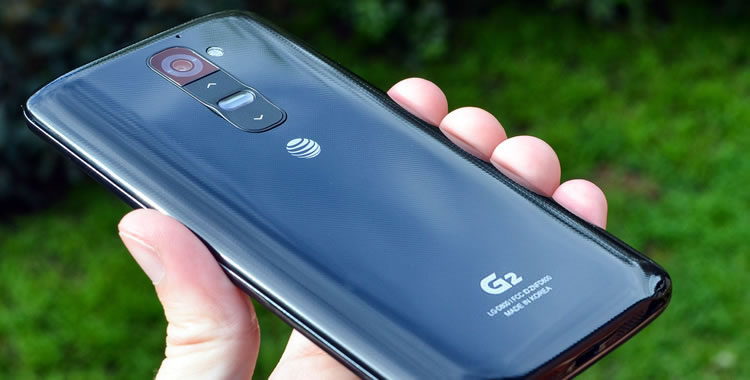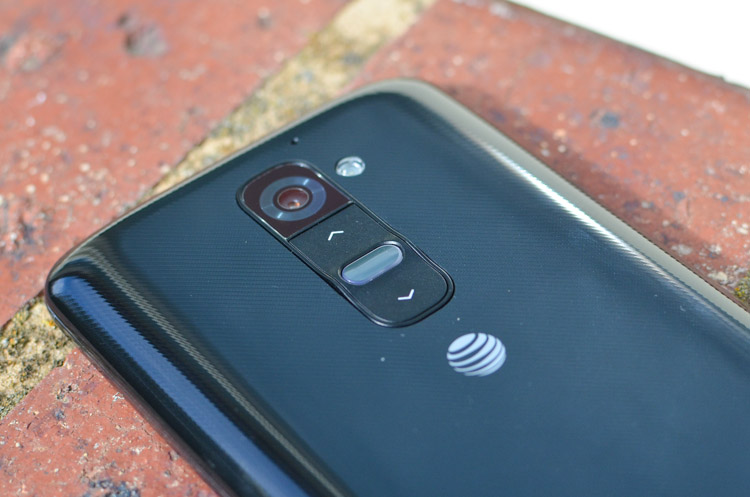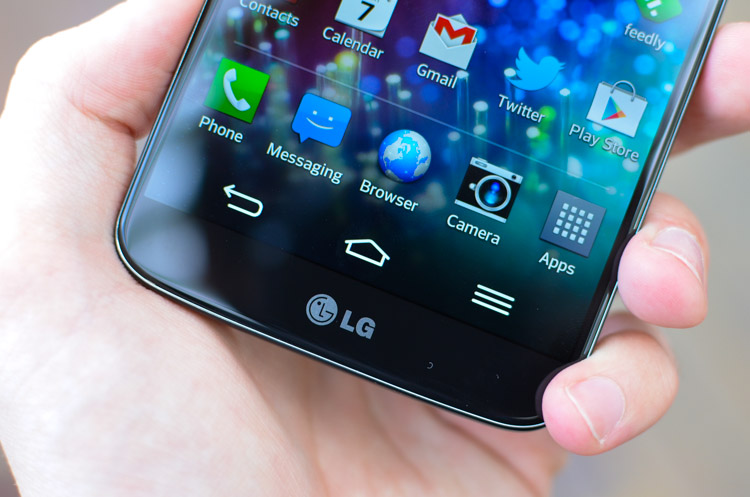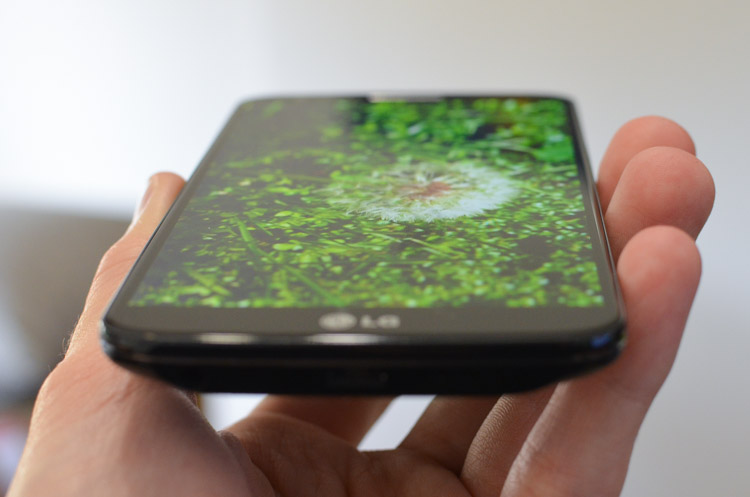It's hard to create a flagship smartphone that stands out from the crowd. When you get into a store and see the Samsung Galaxy S4, HTC One, Sony Xperia Z, iPhone 5s, Nokia Lumia 1020, Moto X and others staring back at you, specifications and features blur together, making a decision to buy one more difficult than ever before.
LG G2 - $570 (unlocked)
- 5.2", 1920 x 1080 True-HD IPS+ LCD display (424 ppi)
- Qualcomm Snapdragon 800 SoC
- 2.3 GHz quad-core CPU, Adreno 330 GPU, 2GB RAM
- 32 GB internal storage
- 13 MP camera, BSI sensor, f/2.X lens with OIS, 1080p 60fps video
- 3,000 mAh, 11.4 Wh battery
- LTE, Wi-Fi a/b/g/n/ac, Bluetooth 4.0, NFC
- Android 4.2.2 'Jelly Bean'
- 143 grams, 9.1mm thick
What has LG done to make that purchasing decision easier? They've jam-packed nearly every feature you can imagine into the G2, from a powerful Qualcomm Snadpdragon 800 SoC and a 1080p display, to an optically stabilized camera and finely tuned software. LG has clearly thrown everything they can into this device, and on paper it looks close to a complete handset package.
Even though the G2 may come with a solid list of specifications, a list doesn't reveal how well the features work together, or how fluid the experience is going to be. Is the LG G2 going to be that ideal competitor to the feature-rich Galaxy S4? Or has LG spent too much time packing in specs and not enough time on refinement?
The LG G2 (AT&T model LG-D800) used in this review was kindly provided by Negri Electronics. No matter where you are in the world (including Australia, US, and abroad), Negri will provide you unlocked smartphones and tablets first and for very competitive prices.
Design
Let's start with the most interesting aspect of the LG G2's design: the strangely-positioned rear buttons. Rather than having the power and volume buttons in their usual positions around the edge of the handset, LG has placed them below the camera on the back panel. The idea is that by removing the buttons from the edge, the display can stretch as far as possible to either side of the device, delivering minimal bezel.
The thinness of the bezel to the left and the right of the display is impressive, and allows the 5.2-inch display to fit into a body that's effectively the same size of 5-inch devices such as the Samsung Galaxy S4. However by moving the buttons to the rear of the device, it takes a couple of weeks after you first use the G2 to adjust to the odd positioning; without fail you'll go to press the side or top of the device to turn it on, and not be able to find a button to do so.
After you've adjusted to the unusual positioning, it actually becomes really comfortable to use. LG has placed the button in exactly the right spot on the rear panel so that it doesn't require an awkward hand position to access, and I had no issues trying to find the button without having to see it. For those people who find it annoying to access, LG has packed a software feature that allows you to double-tap the display to turn it on.
The front of the LG G2 appears classy, with a single piece of toughened glass protecting a dominating display. Next to the speaker grill on the top panel there's a front-facing camera, sensor array, and the ever-useful notification light. Combined with a smooth glass panel, the edge-to-edge display and the lack of a rim around the front panel, the display is an absolute pleasure to use.
The back of the G2 is made of smooth plastic with diagonal highlights, which is disappointing in two ways: the plastic panel is a major fingerprint magnet, while it also looks and feels a little cheap. It doesn't appear as cheap as the Galaxy S4's design, but when you have a well-crafted front panel, it's a little bit of a letdown when the back hasn't received the same polish.
The handset is comfortable to hold thanks to the curved design. LG wasn't all that interested in breaking slimness records, with the device measuring 9.1mm thick, but it's unlikely you'll feel the size in your hands, or care. Through keeping the device this size, LG has managed to pack in an 11.4 Wh battery, and in most cases it's preferable to have a large battery rather than a 6mm thin phone.
All the ports on the G2 are found on the bottom edge, with the microUSB port in the middle and the 3.5mm headphone jack to the left. Interestingly there are two speaker grills on this panel as well, although there's only a speaker behind one of them; the other one is fake, included only for design reasons. The top edge has a small IR LED to facilitate the TV control functionality, along with a microphone.
It's not the nicest design I've seen for a flagship smartphone, but the LG G2 is ergonomic and functional, with the large display fitting snugly into the front panel with minimal bezel. Surprisingly, the rear buttons are easy to use, and it makes an interesting change-up to the standard smartphone layout.
Display
Each year, smartphone display technologies reach new milestones. In 2013 we saw the introduction of 1080p, alongside significant improvements in both AMOLED and LCD panel quality. The G2 features a 5.2-inch True-HD IPS+ TFT LCD panel produced by LG with a resolution of 1920 x 1080, for a pixel density of 424 pixels-per-inch; it's undoubtedly a quality display.
LG's 5.2-inch IPS display used on the G2 occupies 74.5 sq. cm, which is approximately 76% of the device's front panel. The 0.2" size increase compared to the Galaxy S4 and Xperia Z's displays is noticeable, and through occupying a significant portion of the device's front you get the illusion that the display is even larger.
The device features on-screen buttons for home, menu and back which reduces the effective screen size to 4.9" diagonally in most applications. When watching videos, though, the full 1080p display is purposed, and compared to the Galaxy S4's low control buttons, the G2's are in a comfortable position at the bottom of the display. Interestingly you can change the layout of these buttons in the settings, choosing to add in a fourth to pull down the notification panel or launch QuickMemo. I was a little disappointed that you couldn't add in an app switcher button, but this can still be accessed through long-pressing the home button.
The True-HD IPS+ TFT LCD panel is bright, vibrant and color-accurate, making images pop without falling into the trap of oversaturation. The display exhibits strong, even black levels, with only very slight backlight bleed along the top edge; this allows the panel to have superb contrast, with untinted whites also adding to the package.
The True-HD IPS+ technology delivers impressive viewing angles, with only slight dips in brightness (and no color alteration) when viewing the display at angles other than the normal. This is helped by very few layers between the LCD crystals and the glass, which also makes the display appear as if it's part of the glass layer, rather than sitting far below it. The screen also features a polarization layer for increased visibility in direct sunlight. Generally speaking I was impressed with how the display can be seen outdoors.
The pixel density of the 1080p display is absolutely fantastic, and it helps make images and text on the screen look as good as paper. At 424 ppi you won't be able to ascertain individual pixels without some sort of magnifying glass, with the display having awesome clarity and no jagged edges to speak of. Also, as the LCD panel uses a standard RGB subpixel matrix as opposed to a PenTile matrix seen on AMOLED displays, the G2's panel looks a notch crisper than, say, the Galaxy S4's display.
Comparing the G2's display to other flagship smartphone displays, I'd put it very close to the top. It certainly has better viewing angles than Sony's eIPS LCD (Xperia Z), it's brighter than Samsung's Super AMOLED (Galaxy S4), it's more vibrant than Nokia's AMOLED (Lumia 925) and larger, but slightly less color accurate than Apple's IPS LCD (iPhone 5s). I still rate the Super LCD 3 panel used on HTC's devices as the best I've seen, but the wide strengths of the LG's True-HD IPS+ panel make it a very solid inclusion in the LG G2.













